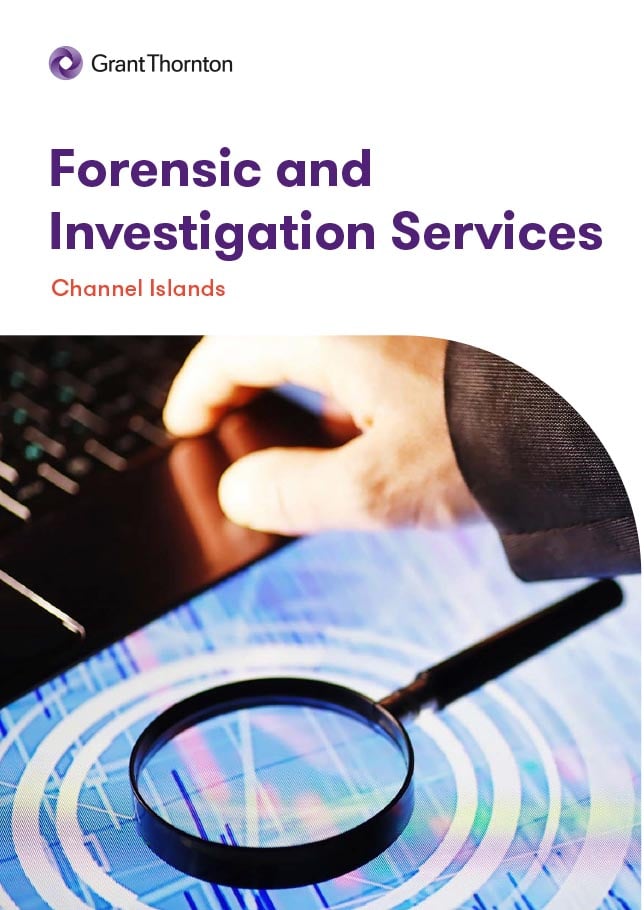-
Sector Focus
We specialise in the investment management industry offering audit, assurance, tax and corporate recovery and liquidation services.
-
Personal Tax Services
There are many tax rules that can affect you personally and therefore which will have an impact on your personal wealth.
-
QI Compliance
Qualified Intermediaries (QI) have to take action now to perform a Certification to the Internal Revenue Service (IRS).
-
Download our tax brochures
The tax teams at Grant Thornton aim to provide the Channel Islands with a premier tax advisory service both to private clients and the business community including the investment management industry.
-
Jersey Tax Return
A secure sign in page to file Jersey Tax Returns through the Grant Thornton tax portal.
-
ESG
ESG can either be seen as a risk management tool or an opportunity, either way it is imperative to your business, whatever your size and whether you are listed or not.
-
Professional Services
Business and accounting support for professional services
-
Finance Industry
We work with a broad range of clients and their financial stakeholders, from entrepreneurs in the early days to fast growing and established businesses to public companies competing in global markets.
-
Local Businesses
Businesses come in many shapes and sizes – from innovative start-ups to long-established local businesses. But however large or small your business, the chances are you face similar challenges.
-
Corporate Insolvency
Our corporate investigation, Guernsey liquidation and recovery teams focus on identifying and resolving issues affecting profitability, protecting enterprise value and facilitating a full recovery where possible.
-
Corporate Simplification
Redundant corporate entities can over complicate group structures and waste thousands of pounds in unnecessary costs each year. 46% of the c.15,500 companies controlled by the FTSE100 are dormant and it is estimated that the average cost of administering dormant companies is between £3,500 and £5,000 per company, per year.
-
Debt Advisory
Our Debt Advisory team provides commercial and financial debt advice to corporate entities and public sector bodies in a range of sectors. Our engagements include advice on stand-alone transactions and solutions or as part of an integrated business plan, in both the project and corporate arenas.
-
Exit Strategy Services
We offer a tailored methodology designed to enable a company to be reviewed in a group context to assess ways to maximise its value.
-
Financial Restructuring
For companies challenged by under-performance we work with management teams, shareholders, lenders and other stakeholders to implement financial restructuring solutions creating a stable platform for business turnaround.
-
Strategic performance reviews
Strategic performance reviews analyse the key drivers of performance improvement. Our specialists utilise a framework to evaluate financial and operational options and to identify solutions for businesses and their stakeholders.

Occupational fraud is fraud in the workplace, committed against an organisation by its employees, management, directors and third parties, and can be split into three main categories - asset misappropriation, corruption and financial statement fraud.
Occupational fraud is the most common form of fraud and is ubiquitous, affecting organisations of all sizes and across all industries. Global losses to occupational fraud are estimated to equate to USD 5 trillion every year[1], but given the concealment and deception of fraud schemes, the true loss is likely to exceed this.
The rapid growth and emergence of advanced Artificial Intelligence (“AI”) tools, such as deepfake technology, sophisticated phishing and spear-phishing schemes and complex software to forge and generate fictitious documentation has equipped the occupational fraudster with an arsenal of fraud weapons to use against their organisation. The FIU reported in quarter 1 of 2024 that 25% of all SARs related to suspicions of fraud highlighting the scale of this issue within professional services.
Tips and reporting remain the most effective ways to combat occupational fraud, with 43% of all fraud detection arising from tips. 52% of these originate from employees within an organisation[2], meaning your employees are a key part of a company’s defence when it comes to preventing and detecting fraud schemes that will harm your business.
Who are the perpetrators?
Occupational fraud schemes are perpetrated by individuals at all levels within an organisation, and victim entities span all sectors and industries. As detailed in the ACFE’s Occupational Fraud 2024: Report to the Nations, non-profit entities experience the lowest median loss to fraud cases at USD 76,000 whereas government organisations, public and private companies lose more on average at USD 150,000 per case. When considering differing sectors, the Mining industry poses the highest risk to occupational fraud, with a median loss of USD 550,000 per case, while banking and financial services reported a median loss of USD 120,000 and professional services experiencing slightly lower losses at USD 100,000. In addition, corruption accounts for 44% of all fraud cases in the banking and financial services industry.
The level of seniority of employees plays a significant role in the type of fraud committed and the overall loss suffered. While 78% of all fraudsters acting against companies are employees or managers, owner/executive fraud is 7 times costlier than frauds carried out by employees, with the median loss for director-driven fraud being USD 459,000. Manager level fraud accounts for 41% of all cases with a median loss of USD 184,000, and employee-driven fraud has the lowest average loss of USD 60,000. These statistics show that individuals in positions of authority, who can potentially exert pressure on others and override controls, are likely to cause the most financial damage to an organisation through occupational fraud.
Length of service also directly influences the cost of each fraud with the median loss for fraudsters with 10 years of service or more being USD 250,000, compared with those serving just 1 year or less averaging only USD 50,000 median loss per case. This suggests that an individual’s experience, knowledge and understanding of an entity and its controls and policies allows more sophisticated frauds to be committed, resulting in a greater loss. Interestingly, fraudsters over 50 years of age cause the highest median loss at USD 350,000, again suggesting seniority and experience within a business presents a greater opportunity for fraud.
In addition to these attributes, collusion serves to further increase the complexity and costliness of frauds, with the median loss for cases involving two perpetrators being USD 250,000 compared with USD 75,000 for a fraudster acting alone.
As is evident, regardless of the organisation or industry, the threat of fraud cannot be avoided; however, the risk of falling prey to occupational fraudsters can be minimised through the adoption and careful implementation of key prevention and detection tools.
Prevention
Fraud cannot be eliminated. It is growing and evolving all the time and will only become more sophisticated and harder to detect given the continued evolution of AI and its malicious use by bad actors. This will likely result in more cases and higher median losses. However, organisations can protect themselves against both the frequency of fraud cases and, when it does occur, the extent of the loss suffered.
Training and raising awareness generally present a cost-effective way to reduce the instance and cost of fraud. The ACFE report that training for managers and executives reduces the value of each fraud case by as much as 50%, and training for employees reduces the cost of fraud by 47%. As 52% of all fraud-related tips come from employees, training staff on the ‘red flags’ and what to look for is the first step to protecting your organisation from fraud.
A typical fraud case spans a period of 12 months before being detected and the longer a fraud case continues, the higher the resultant loss. Surprise audits can be an effective method to uncover fraud at an early stage and can reduce the cost of a fraud by up to 63% compared with organisations that do not utilise such a control. The external audit of financial statements is another important control when fighting fraud and can reduce losses to fraud by 52%.
Specific anti-fraud policies should be implemented alongside a code of conduct, with periodic refresher training around these documents conducted. Organisations with these controls in place see a reduction in fraud losses of 50%.
Ultimately, occupational fraud is not going anywhere and it will continue to be risk to all businesses operating in all industries. However, with robust policies in place and regular and effective training, the risks can be reduced to an acceptable level.
[1] ACFE Occupational Fraud 2024: A Report to the Nations
[2] ACFE Occupational Fraud 2024: A Report to the Nations

Forensic and Investigation Services
Our Channel Islands team comprises of experienced forensic accountants, Certified Fraud Examiners and Data Forensic Practitioners, and our close links with forensic specialists throughout the Grant Thornton International network means that we can quickly assemble cross-border teams and undertake international projects.



